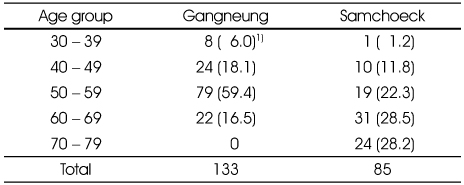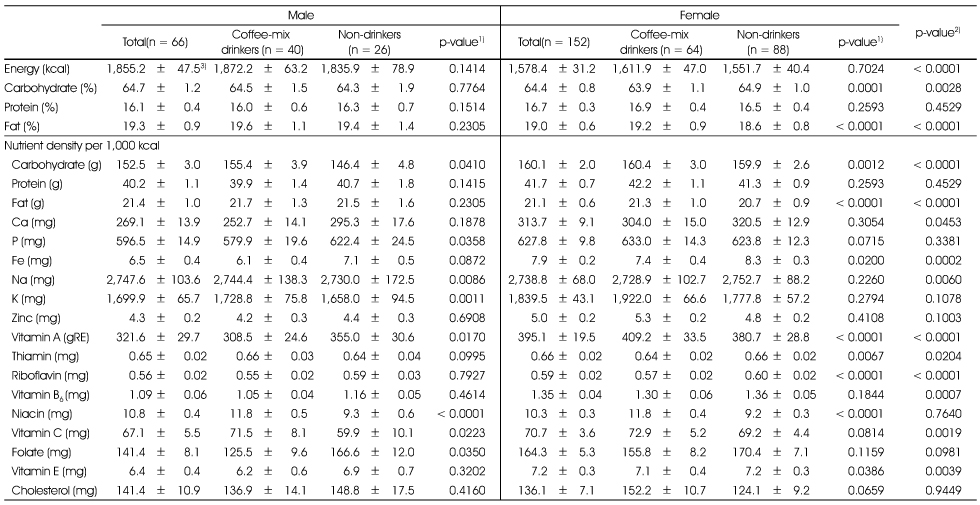Articles
- Page Path
- HOME > Korean J Community Nutr > Volume 18(2); 2013 > Article
-
Original Article
- Correlation of Nutrient Intake, Obesity-related Anthropometrics, and Blood Lipid Status with Instant Coffee-mix Intakes in Gangneung and Samcheok Residents
- Eun Kyung Kim, Jeong Sook Choe, Eun Kyung Kim
-
Korean Journal of Community Nutrition 2013;18(2):134-141.
DOI: https://doi.org/10.5720/kjcn.2013.18.2.134
Published online: April 30, 2013
National Academy of Agricultural Science, RDA, Suwon, Korea.
1Department of Food and Nutrition, Gangneung-Wonju National University, Kangneung, Korea.
- Corresponding author: Jeong Sook Choe, RDA, Gwonseon-gu, Suwon, Gyeonggi-do 441-707, Korea. Tel: (031) 299-0480, Fax: (031) 299-0443, swany@korea.kr
Copyright © 2013 The Korean Society of Community Nutrition
- 1,070 Views
- 2 Download
- 10 Crossref
Figure & Data
REFERENCES
Citations

- Associations between the Genetic Heritability of Dyslipidemia and Dietary Patterns in Korean Adults Based on Sex Differences
Sei Kim, Hye Kyung Jeon, Gyeonghee Lee, Youbin Kim, Hae Young Yoo
Nutrients.2023; 15(20): 4385. CrossRef - Comparison of 24-hour Recalls with a Food Frequency Questionnaire in Assessing Coffee Consumption: The Health Examinees (HEXA) Study
An Na Kim, Jiyoung Youn, Hyun Jeong Cho, Taiyue Jin, Sangah Shin, Jung Eun Lee
Korean Journal of Community Nutrition.2020; 25(1): 48. CrossRef - Association of Dietary Fatty Acid Consumption Patterns with Risk of Hyper-LDL Cholesterolemia in Korean Adults
Eunhee Choi, Seoeun Ahn, Hyojee Joung
Nutrients.2020; 12(5): 1412. CrossRef - Association of coffee consumption with health-related quality of life and metabolic syndrome in Korean adults: based on 2013 ~ 2016 Korea National Health and Nutrition Examination Survey
Hyesook Kim, Yu Jin Kim, Yeni Lim, Oran Kwon
Journal of Nutrition and Health.2018; 51(6): 538. CrossRef - Obesity and Related-factors in Patients with Chronic Mental Illness Registered to Community Mental Health Welfare Centers
Eun-Suk Park, Eun-Hyun Lee
Journal of Korean Academy of Community Health Nursing.2018; 29(1): 76. CrossRef - 3-in-1 coffee consumption is associated with metabolic factors in adults: Based on 2012~2015 Korea National Health and Nutrition Examination Survey
Jee-Young Yeon, Yun-Jung Bae
Journal of Nutrition and Health.2017; 50(3): 257. CrossRef - The effect of coffee consumption on food group intake, nutrient intake, and metabolic syndrome of Korean adults—2010 KNHANES (V-1)
Fangfang Song, JiEun Oh, KyungWon Lee, Mi Sook Cho
NFS Journal.2016; 4: 9. CrossRef - Effect of Coffee Consumption on the Progression of Type 2 Diabetes Mellitus among Prediabetic Individuals
Ji-Ho Lee, Mi-Kyeong Oh, Jun-Tae Lim, Haa-Gyoung Kim, Won-Joon Lee
Korean Journal of Family Medicine.2016; 37(1): 7. CrossRef - Associations of Obesity and Dyslipidemia with Intake of Sodium, Fat, and Sugar among Koreans: a Qualitative Systematic Review
Yoon Jung Kang, Hye Won Wang, Se Young Cheon, Hwa Jung Lee, Kyung Mi Hwang, Hae Seong Yoon
Clinical Nutrition Research.2016; 5(4): 290. CrossRef - Survey on Body Image Perception, Dietary Habits and Nutrient Intakes according to Interest Level in Health of Female University Students in Gyeongnam Area
Eun-Hee Seo
The Korean Journal of Food And Nutrition.2015; 28(2): 281. CrossRef
Age distribution of study subjects
1) N (%)
Anthropometric measurements and blood lipid of study subjects
1) Difference between coffee-mix drinkers and non-drinkers were calculated by ANCOVA (age, region adjusted).
2) Difference between men and women were calculated by ANCOVA (age, region adjusted).
3) Mean ± SE
Coffee-mix intake, frequency and nutrient intake from coffee-mix of study subjects
1) Difference between male and female were calculated by ANCOVA (age, sex adjusted).
2) Difference between Gangneung and Samchoeck(Total Group) were calculated by ANCOVA (age, sex adjusted).
3) Mean ± SE
Correlation coefficient between daily coffee-mix intake or its contribution to energy intake(%kcal) and anthropometric measurements and serum lipids(age, sex, region adjusted)
Energy intake and nutrient density according to coffee-mix intake
1) Difference between coffee-mix drinkers and non-drinkers were calculated by ANCOVA (age, region adjusted).
2) Difference between men and women were calculated by ANCOVA (age, region adjusted).
3) Mean ± SE
1) N (%)
1) Difference between coffee-mix drinkers and non-drinkers were calculated by ANCOVA (age, region adjusted). 2) Difference between men and women were calculated by ANCOVA (age, region adjusted). 3) Mean ± SE
1) Difference between male and female were calculated by ANCOVA (age, sex adjusted). 2) Difference between Gangneung and Samchoeck(Total Group) were calculated by ANCOVA (age, sex adjusted). 3) Mean ± SE
1) Difference between coffee-mix drinkers and non-drinkers were calculated by ANCOVA (age, region adjusted). 2) Difference between men and women were calculated by ANCOVA (age, region adjusted). 3) Mean ± SE

 KSCN
KSCN





 Cite
Cite


